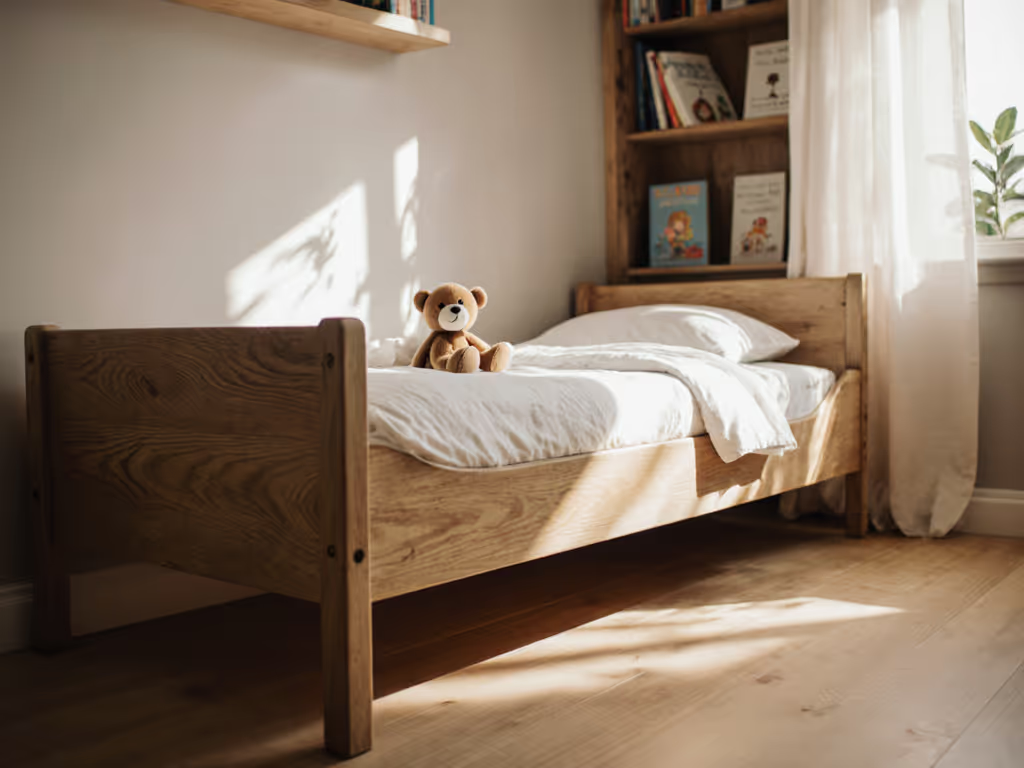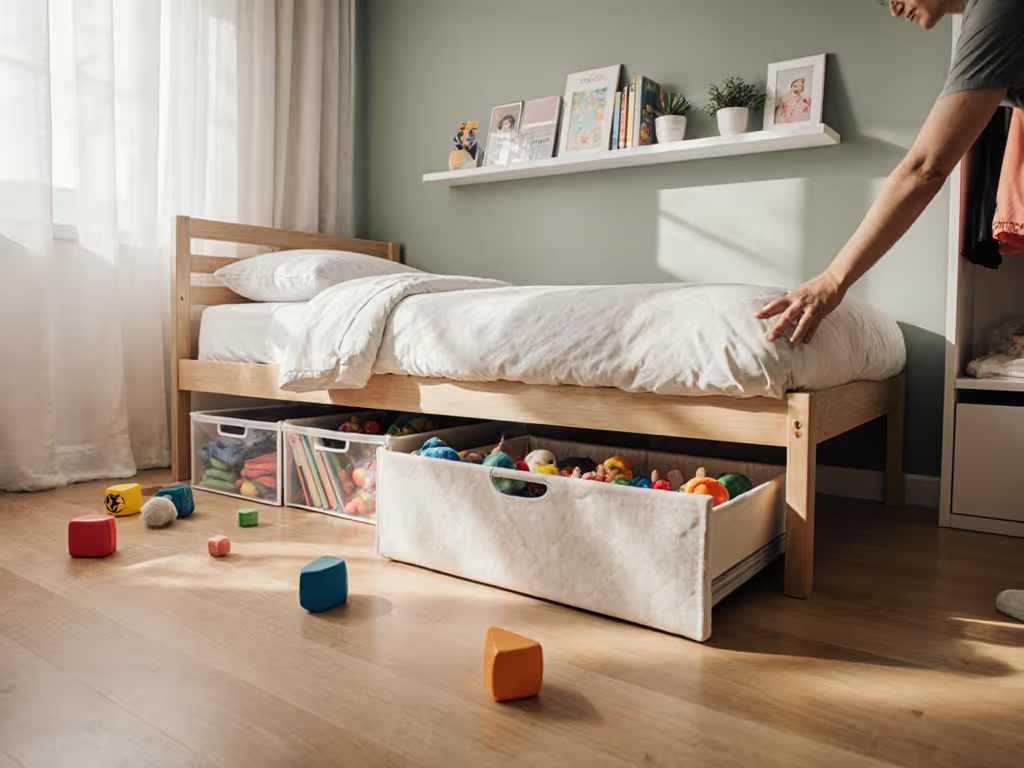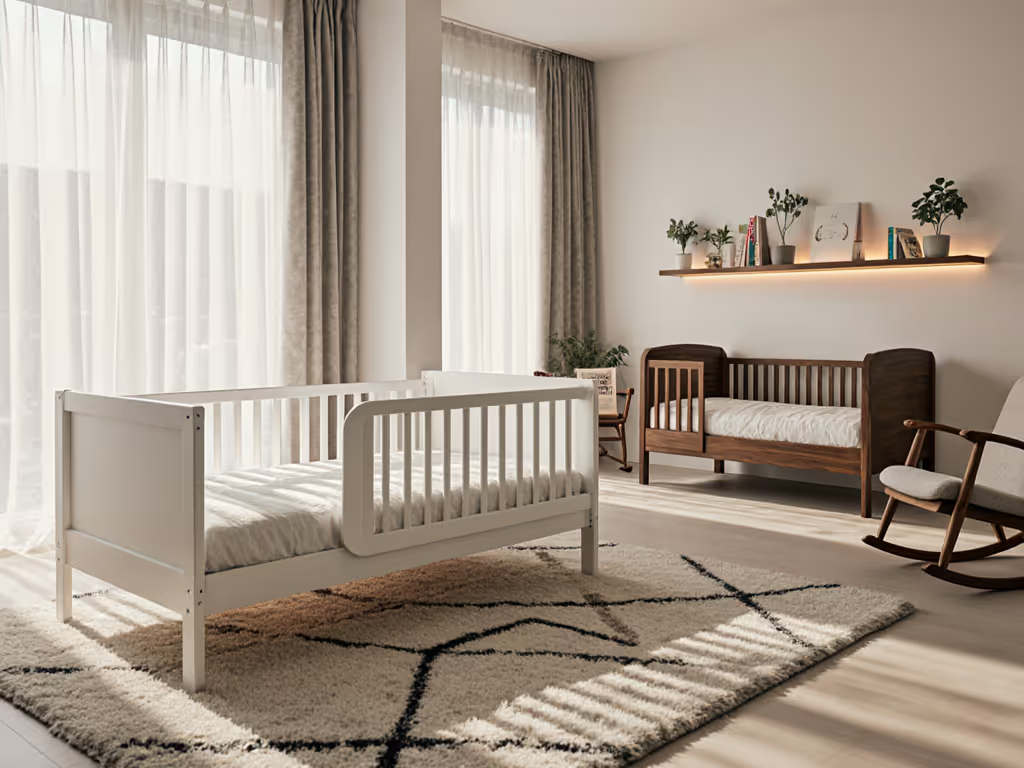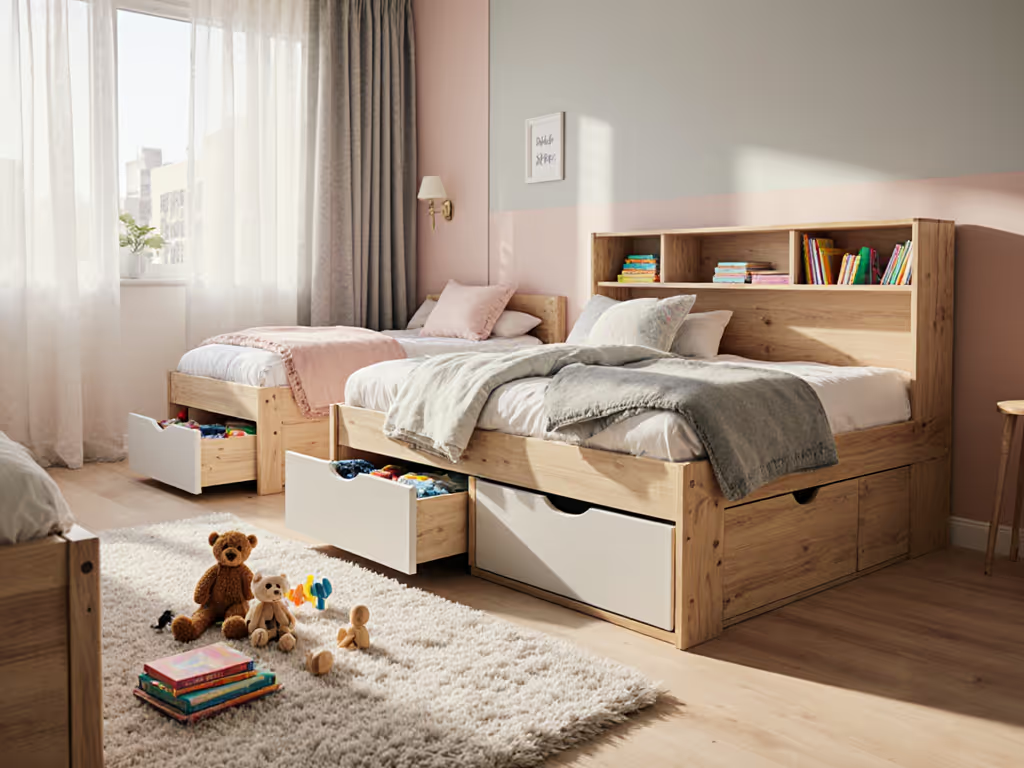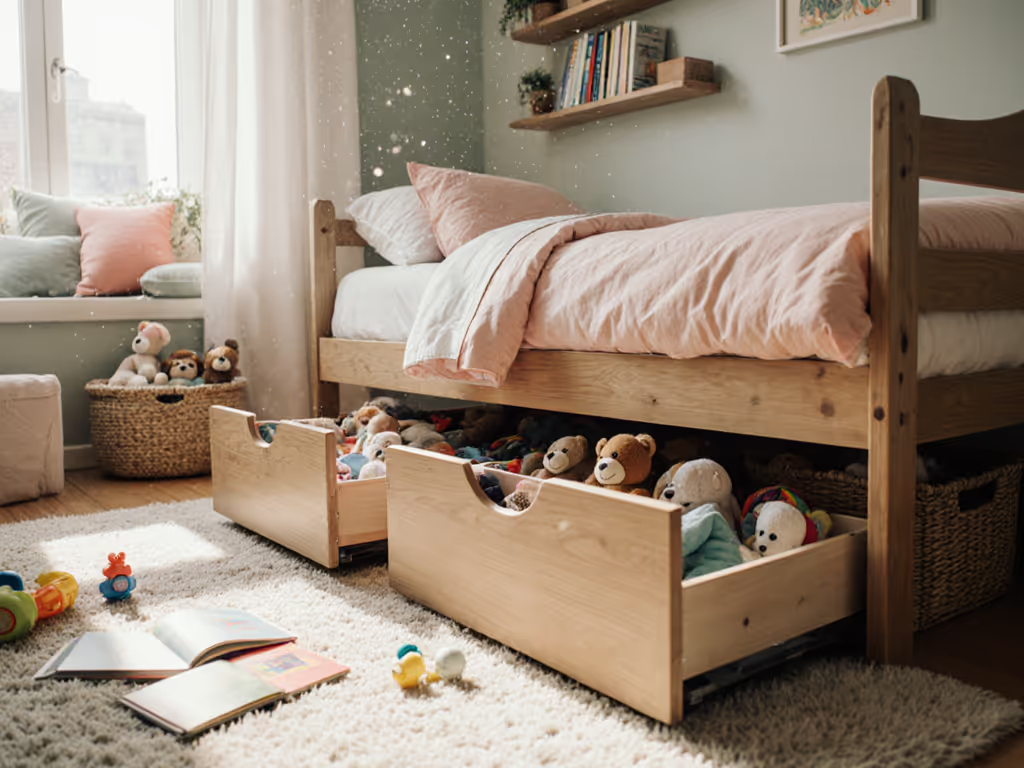
7 Key Benefits of Space-Saving Beds for Toddler Rooms
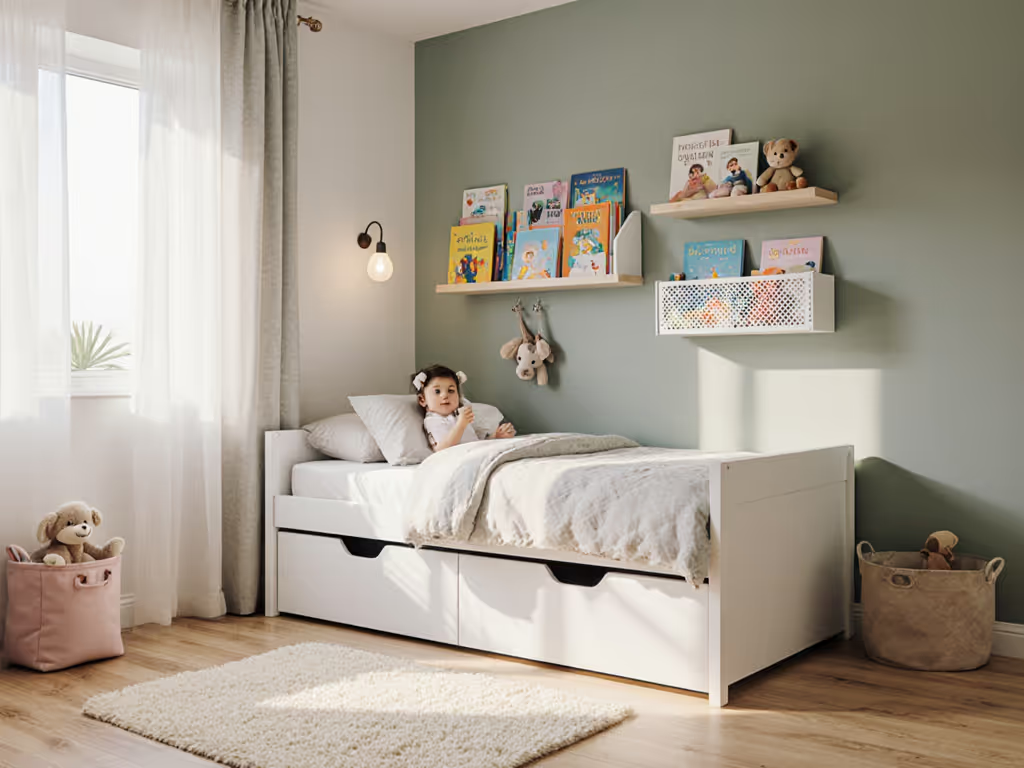
Did you know that children spend up to 70 percent of their time indoors during early childhood? The way you design your toddler's room can dramatically shape their daily routines, safety, and development. Balancing comfort, organization, and aesthetics in a small space might seem challenging, but the right furniture choices can open up a world of learning and play for your little one while making life easier for you.
Quick Summary
| Takeaway | Explanation |
|---|---|
| 1. Choose Compact Toddler Beds | Compact beds reclaim floor space for play and learning, enhancing room functionality. |
| 2. Integrate Storage Solutions | Beds with under-bed storage simplify organization, teaching kids responsibility through designated spaces. |
| 3. Prioritize Safety Features | Low-profile beds reduce fall risks while promoting independence by allowing safe, easy access. |
| 4. Support Bed Transition Process | Use familiar bedding and involve your toddler to ease the emotional shift from crib to bed. |
| 5. Opt for Convertible Designs | Convertible beds adapt as your child grows, providing long-term value by serving multiple needs over time. |
1. Maximize Floor Space for Play and Movement
Parents know the ultimate challenge of creating a functional toddler room that balances sleep space and play area. Toddler beds are the secret weapon for transforming cramped bedrooms into dynamic play zones.
Traditional single beds consume significant floor real estate, leaving little room for developmental activities. Toddler beds solve this problem by offering a significantly smaller sleeping surface that frees up precious square footage. Imagine reclaiming 20 to 30 percent of your floor space just by choosing a more compact bed design.
The strategic benefits extend beyond mere square footage. By selecting a compact toddler bed, you create dedicated areas for critical developmental activities:
- Setting up soft play mats for motor skill development
- Adding a small changing table or storage unit
- Creating a reading nook or learning corner
- Providing open floor space for active play and movement
Vertical sleeping solutions like toddler bunk beds take space optimization even further. These innovative designs stack sleeping areas, essentially doubling your floor space potential. Your toddler gets a comfortable bed while you gain an entire play zone right in their bedroom.
Practical implementation means measuring your room and visualizing potential layouts before purchasing. Look for beds with built-in storage or those that can be positioned against walls to maximize usable floor area. Remember that every inch counts when designing a toddler's room.
Ultimately, a well-designed toddler bed transforms bedroom constraints into opportunities for growth, play, and learning. Your little one gains a cozy sleep space while maintaining room for imagination and active exploration.
2. Simplify Room Organization and Storage
Toddler rooms are notorious for becoming chaotic landscapes of scattered toys and misplaced clothing. Specialized toddler beds with integrated storage solutions transform bedroom management from overwhelming to effortless.
Under-bed storage represents a game changing approach to maintaining an organized children's space. By incorporating pull-out drawers and rolling storage bins directly into the bed design, parents gain strategic compartments for managing everything from extra bedding to seasonal clothing and favorite toys.
The psychological benefits of smart storage extend beyond mere tidiness. When children have designated spaces for their belongings, they learn valuable organizational skills. Imagine teaching your toddler to put away toys in their own dedicated drawer—a simple yet powerful lesson in responsibility.
Practical storage strategies include:
- Creating labeled drawer sections for different item categories
- Choosing beds with multiple storage compartments
- Installing pull-out bins that are easy for small hands to manage
- Selecting neutral colored storage solutions that blend with room decor
Loft beds with integrated shelving take organization to another level. These innovative designs provide vertical storage solutions that capture unused space while keeping floor areas open. Your toddler gains a cozy sleeping spot and a personalized organizational system simultaneously.
Successful room organization requires thoughtful planning. Measure your available space carefully and select storage solutions that grow with your child. Look for adjustable designs that can adapt as your toddler's storage needs change over time.
Ultimately, the right toddler bed transforms bedroom chaos into a structured environment that supports your child's developmental need for order and predictability.
3. Promote a Safer Bedroom Environment
Parent instincts kick into overdrive when it comes to child safety and nowhere is this more critical than in a toddler's sleeping space. Specialized toddler beds are engineered to dramatically reduce potential injury risks while supporting your child's growing independence.
Traditional beds pose numerous safety challenges. High mattress heights and steep sides can create significant fall risks for curious and active toddlers. Low profile platform beds solve this problem by keeping sleeping surfaces closer to the ground—minimizing potential injury distances and providing easier access for young children.
The Montessori approach to bedroom design offers profound insights into creating safer sleep environments. These beds encourage self sufficiency while fundamentally reducing accident potential. By allowing toddlers to independently enter and exit their sleeping space, you simultaneously promote confidence and safety.
Key safety features to consider include:
- Low to ground bed designs
- Rounded protective edges
- Sturdy construction without sharp corners
- Built-in side rails for additional protection
- Minimal gap between mattress and frame
Practical implementation means carefully evaluating bedroom layout beyond just the bed itself. Ensure surrounding areas are free from potential hazards like unstable furniture or dangling electrical cords. A toddler proofed room transforms the bed from a potential danger zone into a secure personal space.
Research suggests that children who can safely navigate their sleeping area develop stronger spatial awareness and motor skills. A well designed toddler bed becomes more than just a place to sleep—it becomes a developmental tool that supports physical and cognitive growth.
Remember that safety is an ongoing process. Regularly inspect the bed for wear and adjust your approach as your toddler grows and develops new skills.
4. Support Easy Transitions from Crib to Bed
Moving from a cozy crib to an open bed represents a significant milestone in a toddler's life. Toddler beds are specifically designed to bridge this developmental gap smoothly and reduce emotional stress during the transition.
The psychological comfort of familiarity plays a crucial role in helping children adapt to new sleeping arrangements. Toddler beds maintain similar design elements to cribs—such as low enclosures and comparable mattress sizes—which help preserve a sense of security. This strategic approach minimizes anxiety and makes the shift feel more natural for your child.
Montessori inspired design principles offer additional insights into creating comfortable transitions. Floor beds represent an evolutionary approach that supports a child's growing need for independence while maintaining a sense of safety. These beds allow toddlers to enter and exit their sleeping space independently, building confidence and motor skills simultaneously.
Strategies for a smooth bed transition include:
- Involving your toddler in bed selection
- Maintaining consistent bedtime routines
- Using familiar bedding from their crib
- Creating excitement about the new sleeping space
- Praising independent sleeping behaviors
Parents can further ease the transition by preparing the bedroom environment. Remove potential obstacles, ensure soft flooring around the bed, and create a welcoming space that feels both secure and exciting. Consider using gentle nightlights or comfort objects that provide additional emotional reassurance.
Remember that every child adapts differently. Some may embrace the change immediately while others require more time and patience. Approach the transition with positive reinforcement and understanding.
Ultimately, a well-chosen toddler bed becomes more than just a piece of furniture. It represents a developmental tool that supports your child's growing sense of autonomy and self confidence.
5. Encourage Independent Sleep Habits
Independent sleep skills are a critical developmental milestone that begins in early childhood. Toddler beds serve as powerful tools for nurturing self sufficiency and building confidence in young children's nighttime routines.
Traditional sleeping arrangements often create dependency patterns where children rely entirely on parents for comfort and settling. Specialized toddler beds break this cycle by creating environments that naturally encourage self regulation and personal agency. When children can independently enter and exit their sleeping space, they develop a sense of control and mastery over their personal environment.
The Montessori approach provides profound insights into fostering sleep independence. By designing sleeping spaces that respect a child's growing autonomy, parents can support emotional and cognitive development simultaneously. Low profile beds positioned close to the floor allow toddlers to make autonomous choices about rest and movement.
Practical strategies for encouraging independent sleep include:
- Creating consistent bedtime routines
- Designing a calm and inviting sleep environment
- Celebrating small achievements in self settling
- Using positive reinforcement techniques
- Allowing natural exploration of sleep space
Parents play a crucial role in supporting this transition. Approach independent sleep as a gradual learning process rather than an immediate expectation. Some children adapt quickly while others require more gentle guidance and patience.
Additional considerations involve creating a predictable sleep environment. Soft lighting, comfortable bedding, and minimal distractions can help toddlers feel secure while developing self soothing skills. Consider introducing comfort objects that provide emotional support without creating total dependency.
Remember that sleep independence is not about abandoning your child but empowering them to develop healthy self regulation skills that will serve them throughout their lifetime.
6. Adapt to Growing Needs with Versatile Designs
Parents investing in children's furniture face a challenging reality of constant change. Convertible toddler beds represent a smart solution that grows alongside your child, transforming from infant sleeping space to versatile youth furniture.
Traditional single purpose beds quickly become obsolete as children develop. Modular and adaptable bed designs solve this economic challenge by offering multiple configuration options. Imagine a single bed investment that can transition through several stages of childhood without requiring complete replacement.
Convertible bed designs typically provide remarkable flexibility. These innovative furniture pieces can seamlessly transform from crib to toddler bed to full size bed, potentially serving your child for a decade or more. Such adaptability represents significant long term value for budget conscious families.
Key features to seek in versatile bed designs include:
- Removable side rails
- Adjustable mattress height settings
- Modular storage components
- Easy reconfiguration mechanisms
- Neutral design aesthetics
Practical implementation means carefully evaluating potential bed designs beyond immediate needs. Consider your child's room dimensions, potential future layout changes, and expected growth patterns. Some convertible beds even offer additional options like separate bunk configurations or integrated desk spaces.
Beyond financial considerations, versatile beds support children's developmental transitions. As your toddler grows from requiring protective enclosures to wanting more independent sleeping arrangements, the bed adapts without creating additional stress or disruption.
Ultimately, choosing a versatile bed design represents an investment in both furniture and your child's evolving needs. Smart parents recognize that adaptability creates lasting value far beyond initial purchase price.
7. Enhance Room Aesthetics in Small Spaces
Creating a beautiful bedroom for your toddler does not require sacrificing functionality or space. Thoughtfully designed toddler beds transform small rooms from cramped spaces into visually appealing environments that inspire creativity and comfort.
Traditional furniture often overwhelms small rooms with bulky designs that create visual clutter. Modern toddler beds challenge this approach by integrating sleek aesthetics with intelligent space management. Minimalist frames crafted from light materials can make a room feel more open and breathable while providing essential sleeping functionality.
The Montessori design philosophy offers profound insights into aesthetic room design. Floor beds with simple frames and neutral color palettes create a sense of visual calm while maintaining a warm and inviting atmosphere. These designs visually expand small spaces by reducing visual noise and creating clean lines.
Strategies for enhancing room aesthetics include:
- Selecting beds with neutral color schemes
- Choosing slim profile designs
- Incorporating multifunctional furniture pieces
- Using light reflective materials
- Integrating subtle decorative elements
Parents can further elevate room design by treating the bed as a visual centerpiece. Window nook daybeds or beds with artistic murals can transform sleeping spaces from purely functional areas into imaginative zones that spark a child's creativity.
Consider the psychological impact of room design. A well designed space can support emotional well being by creating a sense of security and inspiration. Light colors soft textures and thoughtful placement can make even the smallest room feel like a magical personal sanctuary.
Remember that aesthetic design is not just about appearance but about creating an environment that nurtures your child's imagination and sense of personal space.
Below is a comprehensive table summarizing strategies and benefits of utilizing specialized toddler beds as discussed in the article.
| Topic | Strategies | Benefits |
|---|---|---|
| Maximize Floor Space | Use toddler beds and vertical sleeping solutions like bunk beds; measure space and visualize layouts. | More room for developmental activities like play and motor skills development. |
| Simplify Room Organization | Choose beds with built-in storage; use labeled drawers and pull-out bins; consider loft beds with shelving. | Promotes tidiness and teaches children organizational skills. |
| Promote Safety | Select low profile beds with protective edges; ensure room is hazard-free. | Reduces injury risks; encourages confidence and independence. |
| Support Transition from Crib to Bed | Involve children in bed selection; maintain routines; use familiar bedding. | Eases emotional stress and supports confidence and autonomy. |
| Encourage Independent Sleep | Create a calm sleep environment; reinforce independence; use positive reinforcement. | Develops self-sufficiency and confidence in sleeping alone. |
| Adapt to Growing Needs | Select convertible beds with removable rails and adjustable components. | Provides long-term value and accommodates growth without frequent replacements. |
| Enhance Room Aesthetics | Opt for minimalist, neutral color beds; use light reflective materials. | Creates visually appealing and calming environments suitable for small spaces. |
Solve Small-Space Struggles With Confidence
Does your toddler's room feel too crowded for both sleep and play? Many parents feel overwhelmed by the challenge of creating a safe, organized, and inviting space for their growing child. The article you just read revealed how space-saving beds can transform limited square footage, ease the crib-to-bed transition, and help toddlers become more independent. Yet, choosing the right setup often brings up new questions about safety, layout, and future-proofing your investment.
Discover peace of mind and practical solutions at citytoddlerbeds.store. Our expert guides explain how to choose beds that maximize space, boost safety, and encourage your child's development in small or shared rooms. Visit our comprehensive resource center for clear tips, safety standards, and smart room setups inspired by the latest research. Make today the day you stop worrying about messy, cramped bedrooms. Explore our advice and start planning a toddler room that's safe, organized, and ready for growth.
Frequently Asked Questions
How can space-saving beds maximize floor space in toddler rooms?
Specialized space-saving beds, like toddler beds and bunk beds, are designed to take up less room than traditional beds. To optimize your toddler's bedroom, consider measuring your space and choosing a bed style that frees up 20-30% of the floor area for play and other activities.
What storage solutions can I find in space-saving toddler beds?
Many space-saving toddler beds come with integrated storage options, like under-bed drawers or built-in shelves. Look for beds that include these features to help keep toys and clothing organized, making it easier for your toddler to learn valuable organizational skills.
Are there safety features in space-saving beds for toddlers?
Yes, space-saving beds often include important safety features like low profiles, rounded edges, and built-in side rails. To ensure your child's safety, choose a bed that minimizes fall risks and allows easy access for your toddler, ensuring a secure sleeping environment.
How do space-saving beds aid in the transition from crib to bed?
Space-saving beds are designed to offer familiar features from cribs, ensuring a smoother transition for your toddler. Involve your child in selecting the bed and maintain bedtime routines to help them adapt comfortably to their new sleeping space.
What are the benefits of using convertible space-saving beds?
Convertible space-saving beds grow with your child, transforming from a toddler bed to a full-size bed over time. When selecting one, ensure it includes adaptable features like removable side rails and adjustable mattress heights, providing long-term value for your investment.
How can I enhance the aesthetics of a small toddler room with space-saving beds?
Thoughtfully designed space-saving beds can make a small room feel more open and inviting. Choose beds with neutral color palettes and slim profiles to create a visually appealing space, blending functionality with aesthetic charm.

